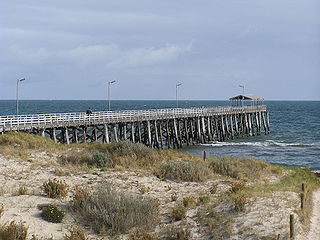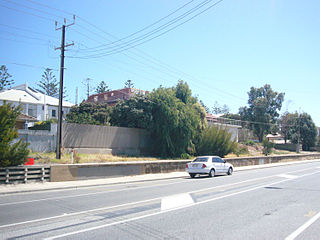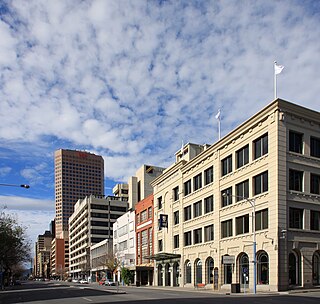
Marino railway station is located on the Seaford line. Situated in the southern Adelaide suburb of Marino, it is 18.3 kilometres from Adelaide station.

The Boston, Revere Beach and Lynn Railroad was a 3 ft narrow-gauge passenger-carrying shortline railroad between East Boston and Lynn, Massachusetts, from 1875 to 1940. Part of the railroad's right of way now forms the outer section of the Massachusetts Bay Transportation Authority's Blue Line rapid transit service.

The Adelaide rail network is a metropolitan suburban rail system serving the city of Adelaide, South Australia, Australia. It consists of 89 railway stations across 7 lines, which served a patronage of 15.6 million people over the year 2018-19. Keolis Downer under contract from the Government of South Australia operates the Adelaide suburban rail system. The operations are set to be handed back to the hands of the public by January 2025.

Rail transport in the Australian state of South Australia is provided by a number of railway operators who operate over the government-owned railway lines. The network consists of 1435 mm standard gauge links to other states, the 1600 mm broad gauge suburban railways in Adelaide, a freight-only branch from Dry Creek to Port Adelaide and Pelican Point, a narrow-gauge gypsum haulage line on the Eyre Peninsula, and both copper–gold concentrate and coal on the standard-gauge line in the Adelaide–Darwin rail corridor north of Tarcoola.

Grange is a coastal suburb of the City of Charles Sturt, in Adelaide, South Australia, located about 11 kilometres (6.8 mi) from the Adelaide city centre. The suburb is named after Captain Charles Sturt's cottage, built in 1840–41, which still stands and is now a museum. In addition to Grange Beach, the suburb has several parks and reserves, as well as the Grange Hotel, which was originally licensed in 1881.

The Grange line is a suburban branch line in Adelaide, South Australia. It is 13.0 kilometres long.

The Seaford line is a commuter railway line in the city of Adelaide, South Australia. It is the city's second longest metropolitan railway line at 35.9 kilometres (22.3 mi).

The Flinders line is a suburban commuter line in Adelaide, South Australia, that branches off the Seaford line at Mitchell Park, and ends opposite Science Park, close to the Flinders University and the Flinders Medical Centre. The line is single track for most of its length, from Celtic Avenue, near Mitchell Park station, to its terminus.

Seaton Park railway station is located on the Grange line and i is part of the Grange Line in Adelaide, South Australia. Situated in the western Adelaide suburb of Seaton, it is 10.3 kilometres from Adelaide station. This railway station serves the suburb of Seaton and is primarily used by local commuters traveling to and from the city center.

Grange railway station is the terminus station of the Grange line. Situated in the western Adelaide suburb of Grange, it is 13 kilometres from Adelaide station.

Paringa is a small town in the Riverland of South Australia, 17 kilometres from the border with Victoria. It is known for its vineyards and almond, citrus and stone fruit orchards. Its main feature is a six-span bridge that crosses the River Murray. One of the spans can be raised to allow houseboats and paddle-steamers to pass underneath.

Henley Beach is a coastal suburb of Adelaide, South Australia in the City of Charles Sturt.

Mile End is an inner western suburb of Adelaide, located in the City of West Torrens, around 2 kilometres from the Adelaide city centre. It has a census area population of 4,413 people (2011). Much of the suburb is residential, but there are small commercial areas along Henley Beach Road and South Road.

The Henley Beach railway line is a defunct railway in western Adelaide, which operated from 1894 to 1957 as the final section of the Grange railway line.

The Adelaide tramways network served much of the inner suburbs and several outer suburbs of Adelaide, Australia, from 1878 until soon after World War II, when it started to decline. The sole Glenelg light rail line, which was the only route to survive the closures, did however remain in operation. After falling into a state of disrepair and neglect, in the 2000s the line underwent major civil engineering upgrades and, progressively, 5.5 kilometres of route extensions; and received a new tram fleet.
Northfield railway station was located 14.3 km (9 mi) from Adelaide station. Despite it being named Northfield, its final location was in the suburb of Pooraka.

Currie Street is a main street in the Adelaide city centre, South Australia. It runs east–to–west from King William Street, through Light Square, to West Terrace on the western edge of the city centre.

Kirkcaldy railway station is a former railway station in the western Adelaide suburb of Henley Beach.
The Melbourne tram network began in 1884 with the construction of the Fairfield Horse Tramway. However, the purpose of the line was to increase land prices in the area, and it soon closed during the depression in 1890. The first genuine attempt to construct a tramway network was the construction of the Richmond cable tram line by the Melbourne Tramway & Omnibus Company in 1885. Over the next few years, 16 more cable tram lines were constructed, as well as numerous other horse tramways. The depression of the early 1890s slowed further expansion of the cable network. The first electric tram line was the Box Hill and Doncaster tramway which opened in 1889. This was a pioneering line in what was then the countryside and thus didn't receive much patronage. It closed in 1896. The next attempt at an electric tramway was Victorian Railways' St Kilda to Brighton line, which opened in 1906. Later that year, the North Melbourne Electric Tramway & Lighting Company opened lines to Essendon and Maribyrnong. Many local councils formed their own tramway trusts and built tramways within their own constituency. The most successful of these was the Prahran & Malvern Tramways Trust.
















